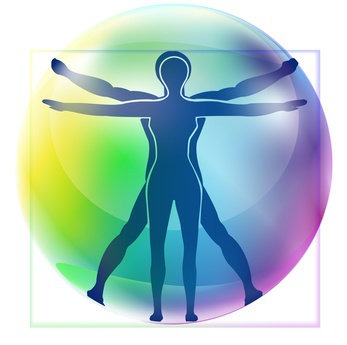
The Human Aura:
The aura is the electromagnetic field that surrounds the human body as well as every other organism and object in the Universe.
An Aura consists of electro-magnetic energies of varying densities that permeate through and emit or exit from the physical body of a living person. These particles of energy are suspended around the healthy human body in an oval shaped field. This “auric egg” emits out from the body approximately 2-5 feet (1 meter on average) on all sides. It extends above the head and below the feet into the ground.
The human aura consists of seven levels or bodies. Each one of the subtle bodies that exist around the physical body has its own unique frequency. They are interrelated, and reflect the person’s feelings, emotions, thinking, and behavior. A state of imbalance in one of the levels can lead to a state of imbalance in the others.
The Auric Bodies (levels of the Human Energy Field):
- Etheric auric body – Physical sensations. Simple physical comfort, pleasure, health.
- The emotional auric body – Emotions about the self.
- Vital auric body – Rational mind. To understand the situation in a clear, linear, rational way.
- Astral (emotional) body – Relations with others. Loving interaction with friends and family.
- Lower mental auric body – Divine will within. To align with the divine will within, to make commitment to speak and follow the truth.
- Higher mental auric body – Divine love and spiritual ecstasy.
- Spiritual (intuitive) body – Divine mind, serenity. To be connected to divine mind and to understand the greater universal pattern.
NOTE: It is NOT necessary to “see” colors and the ability to “see” them is vastly overrated; it is more important to be able to sense or feel them, or to simply know the state of an aura. So, relax and feel into auras without the need to see and enjoy!
Color Meanings
There is no such thing as a bad Aura! Nor are there bad colors. in their pure state all colors are good and useful. When light is blocked or slowed down it will loose its effectiveness and become gray or dull. Everything living has at least four colors appearing in their aura with a variety of shades and hues.
RED: Passion, very active, (deep red) over active, (dull red) burned out, (bright red) sexy, leadership, love of sports, challenge, courage, practical, desire for possessions, sense of adventure, and a survival instinct. Most children have bright red auras – especially males. They are very active and ‘on the go’. Reds like a challenge, is a force of will, hard workers, like to achieve results and success. They do not punch a time clock, and work till they drop.
ORANGE: Creativity, confidence, ambition, originality, sociability, openness, intuition, independence, expression, ability to solve problems and work without supervision. Many talented sales people, entrepreneurs and people who deal with the public have orange auras. Think while they act. They enjoy their sexuality. They love adventure, excitement and intrigue, and often will have multiple partners. They are independent and not emotionally needy. Oranges love to get organized!
YELLOW: Spontaneous, intellect, happy, and cheerful. A sense of humor, confident, optimistic, with a warm smile are typical. People with yellow auras have the ability to brighten the lives of those around them. Yellows bring warmth, originality and exhilaration they usually are playful, fun loving, humorous, and somewhat childlike. They pay attention to details, organization and are disciplined!
GREEN: Healing, teaching, caring, high self-esteem, tenacity, money, harmony, balance, and growth. A rich dark green is abundance, prosperity and wealth. Greens (bright) are driven to be successful and often own their own business, are goal-oriented and make lists (check them off as they complete a goal). Greens need to be in control. Family matters and parenting are important to them. Medical professionals and people involved in the healing arts of any kind often have greens strongly in their auras.
BLUE: Communication, loyalty, good listener, contentment, peaceful, caretaker, calmness, patience, sensitive, honest, empathic, generous, warmhearted, and often times spiritual. Blue indicates a depth of feeling; love, truth, trust, dedication, tranquility, tenderness and affection. Blues cannot think of sex unless they are in love. Blues convey wisdom, and are reliable. A good talker!
INDIGO: Intuitive, observant, aware, open-minded, liberal, tolerant, charitable, shrewd, perceptive, and leadership capabilities. It represents intuitive understanding, serious, use their imagination, inspiration, creativity, and are humanitarians. Indigoes also have healing ability, and are gentle, and compassionate.
VIOLET: Spiritual, mystical, looks for magical solutions, visionaries, always see the big picture, search for the truth, questioning, take everything at face value, tends to be intuitive, and unconventional. People with a lot of violet (purple) in their Aura field tend to live in a world of fantasy and love to daydream. Things come to them without pushing, what they want and need come to them as if by unexplained. They do not have to push to get what they want.
MAGENTA: Nonconformists, innovated, strong-willed, inventive, imaginative, artistic, resourceful, productive, creative and has an agile mind. Magenta’s are bright and determined about things they regard as important. They are great manipulators as well as actors. Magenta’s tap dance to their own tune!
WHITE: Highly motivated, bright, ability to see ‘the big picture’, a chameleon, money is not always the object of their lives, great wisdom. Whites are avid readers and enjoy television, movies, and the theatre ( the main source of social learning for them). White have become the chameleons of the spectrum, assimilating other colors into their aura in order to hide or protect themselves. Often white (if there is a double white in the photo) echo a spirit that is around the person.








